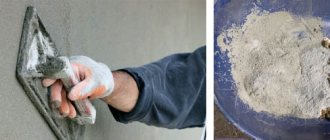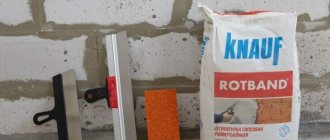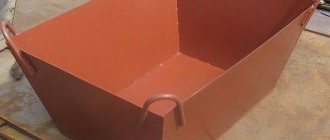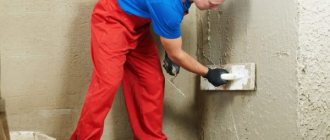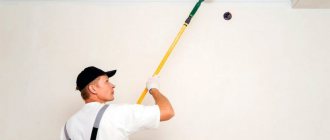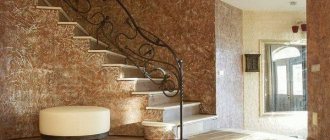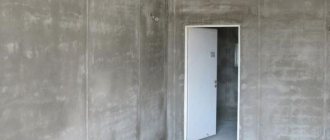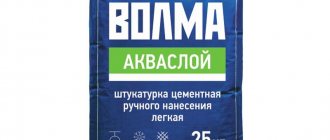Using our calculator you can find out plaster consumption per 1 m2 walls or make a total calculation by area in square meters. The program contains data on gypsum and cement mixtures for finishing interior and facade surfaces from such manufacturers/brands as: Bark beetle, Rotband, Volma, Starateli, Knauf. The maximum layer of plaster is recommended to be no more than 50 mm - more details below. If necessary, you can calculate the cost of material in bags. To get the result, click the " Calculate" You might be interested in putty consumption.
Related regulatory documents:
- SP 71.13330.2011 “Insulating and finishing coatings”
- GOST R 57984-2017 “Plaster for external and internal work. Rules for selection, preparation and application"
- GOST R 57957-2017 “Gypsum binders and plaster”
- GOST 31357-2007 “Dry building mixtures based on cement binder”
Characteristics
The choice of cement plaster composition for walls is determined by the following features:
- characteristics of the base;
- method of application;
- quality of the applied mixture.
According to the purpose of application, the compositions are divided into categories:
- simple, eliminating irregularities and defects in the base;
- special, containing additives to impart the necessary properties;
- decorative, or finishing, used for finishing.
Cement plaster is widely used and can withstand climatic conditions outside and inside the house.
Surface structure before finishing
Final calculation of the required amount of material
Using the data on the packaging, it is easy to calculate the amount of dry mixture that needs to be purchased.
So, for our example with a wall with an area of 12 m2 and a calculated average layer thickness of 3 cm, when using gypsum plaster we get:
3 x 9 x 12 = 324 (kg)
- If the dry mix is supplied in 30 kg bags, you will need to purchase 11 bags.
- For packaging 25 kg - 13 bags.
- For material in 50 kg bags - 7 pieces.
- You will need to buy 33 small 10-kilogram packages.
It is better to buy consumables with a small supply, so that you do not have to make an emergency trip to the store if just a little of the plaster mixture is not enough. And the material from the required manufacturer may simply not be available. It is better to buy an extra bag; the excess can always be used elsewhere.
Thus, having correctly made all the calculations, you can decide on the required budget for repair work, the amount of material purchased and not spend extra money.
Plaster composition
Plasters have different compositions: clay, lime, gypsum, cement, but the most common are cement plasters, which have great durability and stability. To impart the necessary qualities, various additives are introduced.
Types of cement mortar:
- Cement, which consists of cement and sand fraction, is used for plastering internal and external elements.
- Lime, to which lime milk is added, which increases the plasticity of the mixture, is also used inside and outside.
- Cement-clay is recommended for use in conditions of low humidity.
The use of a particular composition is determined by operating conditions.
At high humidity inside and for finishing facades, cement and lime mortars of the required strength are used.
Finished walls
At low humidity, lime plaster and lime-gypsum mixtures can be used for interior and exterior decoration.
Video description
In the video, the master talks about the simplest way to calculate the required number of bags of plaster mixture:
Until recently, when there were no ready-made mixtures on sale, plaster was made by hand using sand, cement and water. For interior work, lime was used instead of cement. And since the most expensive material is cement, builders have always had a question: what should be the consumption of cement per 1 m² of plaster.
Today no one asks this question. No one mixes a bunch of ingredients, preparing mixtures and solutions. Moreover, no one has ever been able to accurately follow the recipe. And the quality suffered as a result.
It is better to make the bottom leveling layer from cheap cement plaster Source yandex.net
Advantages and disadvantages
No material is ideal for all situations. This also applies to a cement-based composition: it has both advantages and disadvantages.
A coating with this composition is used in the following cases:
- Plastering inside and outside.
- Block wall covering.
- Finishing of concrete structures to improve thermal insulation.
pros
- You can mix it with your own hands.
- The finished surface is resistant to moisture.
- Not afraid of temperature changes.
- Provides stable adhesion to various substrates.
- Provides the highest strength characteristics.
- Finishing is cheaper than other mixtures.
- Can be used for any design.
Work on lighthouses
Minuses
- To ensure strong adhesion to wood, ceramics and structures with paint residues, preparatory work is necessary: priming, notching or applying a mesh for reinforcement.
- The applied layer takes up to a month to gain strength.
- The process is labor-intensive: to achieve the required evenness, the experience and qualifications of the performer are needed.
- The surface requires additional operations: grouting, grinding, priming, puttying.
- Due to its significant weight, it increases the load on the building structure.
- When the building shrinks, cracks may form.
Number of PCB bags for brickwork and calculations on a calculator
Laying a brick wall should be done using a mixture with a grade corresponding to the brick. This structure is as durable and uniform as possible. In general, M100-M200 is used for masonry.
So it is necessary to take into account the quality and strength of the material (both the mixture and the brick). Using basic standards, approximately 250 kg of M100 mixture should be used per 1 m3 of wall.
Cement is the main and main component for most buildings and structures. Here's how to properly dilute cement.
The use of sand is a necessary measure when carrying out any construction or repair work. Here everything is about quartz sand.
Kitchen renovation is a very important and serious matter and must be approached with all responsibility. By clicking on the link, you will get acquainted with wall panels for the kitchen made of plastic with photo printing.
If you prepare the solution yourself, then the proportion should be 1 to 4. Liquid should be added to the CPS, which is usually half the total weight of the mixture.
Of course, the laying of a wall greatly depends on the thickness of the seams; as the space between the bricks expands, the amount of mortar per 1 m3 also increases. The thickness of the walls also plays an important role, so for facing bricks laid in 1 layer, significantly less cement is required than for load-bearing walls of 2-4 bricks.
Calculation for masonry
Regulatory documents contain detailed recommendations and the relationship between wall thickness and the amount of mortar used.
Examples are presented based on ordinary bricks and the required quantity per 1 m3:
- wall 12cm - 420 bricks and 0.19 m3 of mortar;
- wall 25cm – 400 bricks and 0.22 m3 of mortar;
- wall 38cm – 395 bricks and 0.234 m3 of mortar;
- wall 51cm – 394 bricks and 0.24 m3 of mortar;
- wall 64cm - 392 bricks and 0.245 m3 of mortar.
Layer thickness calculation
The layer should be sufficient to achieve a smooth surface and hide imperfections based on the minimum thickness. An excess layer, in addition to increasing the cost of work, will lead to a decrease in the durability of the coating. The thickness depends on the condition of the surface, its curvature and material.
comparison table
Depending on the base, the applied layer may be different:
- A brick wall is characterized by good adhesion and the presence of relief; the layer cannot be thinner than half a centimeter. The recommended layer without reinforcement is 2.5 centimeters, with mesh – up to 5 centimeters.
- Concrete has porosity, good adhesion, the applied layer is recommended from 2 millimeters. You should not apply more than 2 centimeters without a mesh; the greatest thickness with reinforcement is up to 5–7 centimeters.
- Aerated concrete and foam block walls are smooth, 2–15 millimeters thick is enough.
- Wood is rarely plastered due to poor adhesion; before finishing it is necessary to attach a mesh, thickness - up to 2 centimeters.
- Plastering the insulation begins with reinforcement, the recommended thickness is no more than 1–2 centimeters.
The thickness is determined after installation of the beacons and depends on the following factors:
- Curvature of the wall, number and size of irregularities.
- Type of mixture.
Table of the ratio of the main material for preparing the solution
If the curvature is more than 5 centimeters, it is better to level the wall with plasterboard sheets.
For accurate measurements, at least three beacons are required.
For each point, deviations are determined, summed, and the resulting value is divided by the number of measurement points.
Example:
The wall is 15 square meters, 3 beacons are installed, deviations are 1, 2, 3 centimeters. The sum of the deviations is 6, divided by 3 beacons, we get a thickness of 2 centimeters.
Gypsum plaster according to GOST
Nowadays, the most popular mixtures for plastering premises are made on the basis of such a universal building material as gypsum. But not all manufacturing companies, due to the constant savings in component materials, strictly follow the letter of GOST. The main regulatory document that precisely specifies the requirements for the production of gypsum mixture is GOST R 57957-2017.
The following are available in GOST:
- Notation.
- Types of gypsum plasters.
- Labeling and packaging.
- Thermal conductivity values of the material after it hardens.
Composition of gypsum plaster
But most often, buyers are interested not in the composition of the plaster, but in its proportions. To find out the components of a dry gypsum mixture, just look at GOST 31377-2008, which consistently describes all the requirements for this product:
- The dry mixture must not contain grains larger than 5 mm. GOST allows the presence of grains measuring 1.25 mm - no more than 1%, 0.2 cm - no more than 12% and 0.125 - no more than 15%.
- Gypsum, which is added to the dry mixture, must be made in accordance with GOST 125.
- After adding water to the dry mixture, the resulting solution should set during manual application in at least 45 minutes. When using any application technique - no less than 90 minutes.
- The water holding capacity should not be less than 95%.
If this GOST is indicated on the box of the purchased mixture, but the quality of the plaster, its hardening time or other characteristics do not meet the requirements of the regulatory document, then each buyer has the right to receive monetary compensation.
Consumption rate
Before starting work, it is necessary to calculate the consumption of the required material. Material consumption rates per 1 m2 of wall depend on the composition of the mixture and the condition of the surface.
By type or manufacturer
Per square meter of improved plaster, 0.0189 is required, and for high-quality plaster, 0.0255 cubic meter of solution is required.
Products from one of the manufacturers
There is a large selection of ready-made mixtures on the market from well-known manufacturers: Knauf, Bergauf. There are also materials from other manufacturers. The most popular compositions with modifying additives and water-repellent properties are produced by Knauf, Bergauf, Hercules.
Calculation of consumption for different types of mixtures
Plaster mortars on the modern market are represented by a fairly wide range. And they all differ from each other in raw material content and texture. Therefore, their plaster consumption per 1 m² varies.
Let's start with non-standard plaster, which is called “Bark Beetle”. Firstly, consumption will mainly depend on the size of the filler. And these are stone granules. That is, it will depend on the fraction of granules. This is the expense:
- fraction 1 mm - material consumption will be 2.4-3.0 kg/m²;
- 2 mm – 5-6 kg/m²;
- 3 mm – 7-9 kg/m².
It cannot be said that these ratios are very accurate. Therefore, experts recommend increasing these figures by 5-10%. By the way, all of the above indicated consumption values apply to gypsum-based plaster mixtures. But there is also cement plaster “Bark beetle”, which is used for finishing facades. It is more durable and has excellent moisture-proof characteristics.
Moreover, this solution is one of the most economical. Manufacturers have set this figure - 3 kg/m². It is clear that taking into account the thickness of the applied layer of 1 cm.
Plaster coating “Bark beetle” Source superstroyka.com
The most commonly used plaster mixture for leveling internal wall surfaces is Rotband gypsum plaster. The classic material of this type with a standard consumption is 8.5 kg/m², taking into account the thickness of the applied layer - 1 cm. If it is necessary to find out the consumption with increasing thickness of the plaster, this figure is multiplied by this thickness. It's simple.
Gypsum plaster Rotband Source prom.st
Venetian plaster is used infrequently, but this particular plaster mixture is considered one of the most beautiful. The reason is the unusual marble texture. It should be noted that Venetian plaster is applied in a thin layer, so its consumption is small. The manufacturer indicates on the packaging that only 70 g of material is required per 1 m² of surface to be finished. Of course, taking into account the thickness of 1 cm.
Such a minimum consumption is achieved only by laying a standard layer of plaster under the finishing in order to level the wall to the maximum. That is, applying the Venetian requires a flat surface. And these are significant costs, taking into account not only the leveling layer, but also the cost of the finishing material itself.
A wall decorated with Venetian plaster Source static.tildacdn.com
Making cement-sand mortar with your own hands
To reduce the cost of work, especially for large areas, you usually prepare the solution yourself, selecting the strength and taking into account the base material.
Cement is hard and non-plastic; it is difficult to apply and level. It sets within an hour, so you need to plan on using more plaster than normal. The most common is a composition where three parts of sand are added to one part of cement.
Proportions
The addition of lime improves ductility; the optimal composition is considered to be a proportion of 1:0.5:5.5, resulting in a solution of strength M75. Usually a cement-lime composition is used, it is suitable for external and internal work. Setting occurs in 1–2 hours; thanks to lime, it adheres better to the base.
Recommended conditions before starting work
The consumption indicated in the regulatory documentation is relevant for certain environmental conditions both indoors and outdoors. Before starting finishing work, you should make sure that:
- The room temperature is at least 10 °C. Air humidity - no more than 60%.
- The room is ready for plastering. To do this, it is necessary to maintain the nominal temperature in it for 2 days before work and 12 days after.
Plastering a brick wall
Only if the above conditions are met, the consumption of plaster per 1 m² will not exceed that stated in the regulatory documentation.
Bark beetle plaster – consumption per 1 m2 of Ceresit brand
This brand represents the products of the German company Henkel on our market and is one of the most popular in the corresponding segment. It should be noted that the range of products includes building mixtures labeled “winter”, intended for low temperature conditions. Let's consider the correlation of material costs with the type of solutions used using this brand as an example.
The polymer cement masses of this company are endowed with both positive and negative characteristics:
- Ease of mixing, creating an easy-to-use homogeneous mass;
- Significant density, making it easy to cover even poorly leveled substrates;
- The manufacturer claims a 10-year service life without the need for restoration manipulations;
- Vapor permeability, preventing condensation at the wall-finish interface;
- Inelasticity, which may cause the finish to crack when the underlying materials expand.
Polymer-cement CeresitCT-35 - sold in 25-kilogram multilayer paper bags in two versions. Composite powder with a grain size of 2.5 mm, according to the data on the packaging, is characterized by a material consumption of 3.2 kg/m². With particles of 3.5 mm, façade plaster bark beetle consumption per m2 will be 4 kg.
Photo from www.ceresit.org
Polymer cement dry mixture CeresitCT-36 is packaged in 25 kg bags and contains 2 mm particles. The need for this variety is determined by the pattern (vertical, diagonal, etc.) and ranges from 2 to 4 kg/m².
Acrylic products of this brand are subject to preliminary tinting in tinting machines. Low vapor permeability makes them suitable for finishing facades insulated with foam plastic or expanded polystyrene. After complete hardening, the structure remains elastic and is not subject to cracking or shedding. The disadvantage of this type is its poor dirt-repellent properties, due to which its use near active highways is limited. If the application method is maintained, the service life will be up to 20 years.
Photo from the site stroymat77.ru
Acrylic paste from the German company CeresitCT-64 with a grain size of 2 mm is packaged in plastic buckets of 25 kg. The final cost will be from 2.7 to 3 kg/m², depending on the preparation of the base.
Silicate compounds are also available in paste form, which must be painted using tinting stands. High vapor permeability values do not allow their use on foam plastic or polystyrene foam thermal insulation systems. Its elasticity after hardening makes it even more durable, with an average service life of more than 25 years before the need for restoration manipulation arises. This surface has antistatic properties that do not allow dust and moisture to penetrate the structure. The facade acquires self-cleaning properties under the influence of rain jets.
Silicate CeresitCT-73 requires preliminary application of CeresitCT-15 primer. The product is packaged in 25 kg buckets. The grain size can be 2mm, and then the bark beetle plaster consumption per 1 m2 will be in the range of 2.7-3 kg. If the selected crumb diameter is 3mm, then you will need 4.2-4.5 kg per square.
Silicone plastering solutions are the most practical and functional, and, as a result, the most expensive type. Pigment is also added in tinting machines. The vapor permeability characteristics are similar to those of silicate, and even exceed them in terms of elasticity, mechanical and chemical resistance. The hydrophobic coating is capable of self-cleaning, thanks to which it will retain its pristine cleanliness for the entire service life of 20-25 years.
Silicone CeresitCT-75 is available for sale with grains with a diameter of 2 mm, giving the consumption of decorative bark beetle plaster in the range of 2.7-4.5 kg. You can also find on sale a mass with a particle size of 3 mm and a final cost of 4.2-4.5 kg/m².
Photo from the site akcent-stroy.com
After completing the calculations, it is better to increase the obtained figures by approximately 10-15%, since reality almost always exceeds the calculated values. This will help protect against shortages of previously purchased products and repeated trips to the store. However, it’s still not possible to buy with an accuracy of up to a gram, and often the rounding goes to the available packaging.
Useful tips
On specialized websites for the sale of building materials, there are always online calculators - a very useful tool that makes it possible to calculate the amount of material based on its characteristics.
To increase the effectiveness of the plaster composition, instead of standard cement-gypsum mixtures, dry industrial compositions, such as Volma or Knauf Rotoband, are often used. It is also possible to make the mixture yourself.
The thermal conductivity of gypsum plaster is 0.23 W/m*C, and the thermal conductivity of cement plaster is 0.9 W/m*C. After analyzing the data, we can conclude that gypsum is a “warmer” material. This is especially felt if you run your palm over the surface of the wall.
A special filler and various polymer additives are added to the composition of gypsum plaster, which makes it possible to reduce the consumption of the composition and be more plastic. Polymers also increase adhesion.
For information on the use and consumption of Knauf Rotband plaster, see below.
Preparatory work
In order to get a high-quality result at the end of the putty work, you need to carefully prepare for this process.
- Preparation of the base (ceiling or wall):
- must be durable;
- dry;
- clean;
- without peeling.
It is necessary to remove dirt, plaque, plaster residues, wallpaper, looseness, oily inclusions, etc.
The wall or ceiling should not be wet or frozen. Before puttying, be sure to dry the base.
- Preparation of the workplace. Since the process of leveling walls is a dusty and dirty job, it is necessary:
- cover the floors with newspapers or special film,
- It is better to remove decorative items and furniture; if this is not possible, then also cover with film (it is sold in the store).
- Preparing tools. You will need a drill with a special attachment (or something you will use to mix the dry mixture manually), spatulas, a container for the composition and a level (if you have to work on leveling the walls/ceiling). All equipment must be clean and dry.
The tool must be washed thoroughly immediately after use, otherwise it may only end up in the trash.
- Preparation of the building mixture (read more about this below).
Types of cement mortars for plaster
Plaster mixtures used for wall finishing differ in the presence of certain components and their ratio. Divided into types:
| Type of mixture | Characteristics | Proportions |
| Cement-sand | They are used for rough interior and exterior finishing, resulting in a durable, moisture-resistant coating. Suitable for finishing walls, ceilings in unheated, damp rooms and for cladding facades. The constituent components are cement and various fillers: sand, plasticizers, etc. | The standard solution is prepared in a ratio of sand and cement 1:3. Cement grade M 400 can be diluted 1 part to 8 parts sand. M 100 is mixed in a ratio of 1:2. The composition is selected depending on the type of surface, layer thickness, and operating conditions. To increase plasticity, add PVA glue to the finished mixture in a ratio of 50-100 ml per 10 liters of the finished solution. |
| Cement-lime | They have good adhesion to all types of surfaces. Used for finishing plinths, cornices made of stone and wood. Lime has bactericidal properties and protects the surface from mold and fungal infections. | 1 part cement and lime to 5 parts sand. For a 25 kg bag of cement we take 21 kg of lime, 280 kg of sand, 50 liters of water. |
The cement composition is most often used for rough finishing of walls. A thin layer cracks during operation, so it is recommended to apply cement-sand mortars with a thickness of 3 to 6 cm, depending on the material from which the walls are made and the plaster application technology used.
Vetonit
When producing vetonite, ingredients such as sand, cement, limestone, polymer glue and mineral additives are used. The main advantages of the material are its environmental friendliness and moisture resistance. The product can be used for finishing internal surfaces where the air temperature is above 10 degrees. The process of hardening and strengthening ends after 7 days. The maximum layer thickness will be 2 – 10 mm. If putty is applied in a layer of 1 mm, its consumption per 1 m2 will be 1.2 kg.
The video describes the consumption of putty per 1 m2 of plaster:
The puttying process is a very important point when performing repair work.
Here it is very important to choose the right composition and calculate its consumption. In this case, it is necessary to take into account many factors, so sometimes the consumption indicated on the packaging differs from the amount of mixture that was actually used
Maybe,
Preparing façade walls for plastering
One of the most important conditions
What determines
the quality of plaster
is its strong adhesion to the surface.
If there is insufficient adhesion the plaster
peels off and then falls off.
Therefore, it must be
properly prepared, i.e.
roughen
it , clean it from dust and other contaminants.
Various surfaces
require different training.
When performing plastering work
it is necessary to preserve
the architectural forms
provided for by the project (
plaster texture, rod profile, moldings around window and door fillings,
etc.), the facade as a whole, as well as its individual elements.
NOTE: Protruding concrete
(
reinforced concrete, brick, wood
)
architectural parts,
a plaster coating
on them with a thickness of more than
20 mm,
are preliminarily covered with a steel mesh with cell sizes of
10x10 mm
or
wire weaving
with cells no larger than
40x40 mm
, fixed on hammered nails.
The mesh
(wire weave) should not sag after being installed in place.
- Concrete and gypsum concrete
Surfaces before plastering, in addition to the above treatment, can be treated:- priming with a 7% solution of polyvinyl acetate emulsion
and subsequent plastering
with gypsum-polymer cement or polymer cement solution
; - washing with a 10% solution of technical hydrochloric acid
.
Before plastering,
the surface of brick, stone and other structures with a 3% solution of hydrochloric acid
, and then
with clean water
.- Stains of non-drying oils
are removed by coating with
a layer of oily clay
, followed by drying and cleaning (sometimes the process is repeated). - from dust, dirt and mortar residues
with a steel brush.
Manual cleaning is only allowed for small volumes of work.
or in hard to reach places.
For large volumes of work, façade cleaning
should be done
mechanically
.
Cleaning the façade surface
using
a sandblasting machine,
perform in the following order:
- The sand is sifted and the sandblaster
with sand. - Install inventory panels in window openings
to protect glazing. - The surface of the walls
is cleaned using
a sandblasting machine
with lifting and lowering, as well as moving
the hose of the device
. - The waste sand
is collected and, if necessary, reused, it is sifted again and the apparatus is refilled. - For 100 m² of façade cleaning
, 0.26 m³ of sand
is consumed .
Boundaries of the plaster layer
If possible, it should be combined
with the architectural division of the facade
, i.e.
with the lines of window openings, pilaster belts, projections, cornices,
etc.
The rods
are made using templates made according to the masonry profile.
The method of plastering the walls of the facade of a residential building
in the window opening area
is shown in Fig. 1.
Exterior plaster
must have a thickness of at least
2 cm
.
When using a porous mortar,
the plaster is applied in one layer, with
all other solutions
- in two layers, and the drop (decrease) in the strength of the layer should go
from the ground outward
.
For walls
exposed to slanting rain, it is preferable to use
water-repellent
or at least
water-retaining types of plaster
, but they should not prevent a sufficient exchange of water vapor between the wall section and the outside air. This can be achieved by painting the plaster.
Masons leave in brick walls
, which are intended
for subsequent plastering
, a small
void
- an unfilled seam between bricks (blocks) to a depth of
15 mm
.
If the waste area is not left, then the masonry seams
are cleaned of mortar to a depth of
10 mm
(for
pillars
- only
vertical seams
).
The purpose of this is to ensure strength
connecting
the plaster layer to the brickwork
due to deeper penetration of the mortar into the wall seam.
But this only applies if the brick
from which the wall is made has a porous structure.
If the brick is smooth
, then you cannot do without additional notching;
the notching
must be done using a chisel and a hammer.
The notch is made with strokes (at least 30 per 1 m²
) with a depth of
3...5 mm
every
50...70 mm
, the sagging of mortar and concrete is cut off.
Practice has shown that in small areas the notch can be replaced
applying
a solution of PVA glue with cement
.
Insufficiently rough surfaces
, for example,
concrete
, made in metal, board (planed) or plywood formwork, must be processed (by cutting, notching or sandblasting) until a texture is obtained that provides the
necessary adhesion to the plaster
, which is determined by trial plastering of individual places.
Wooden surfaces
must be prepared
for plastering
as follows:
- The surface is thoroughly cleaned of dust and dirt.
- Wooden surfaces are covered with a layer of waterproofing material
(tar paper, glassine). - Then the surfaces are covered with shingle boards
with clear cell sizes of
45x45 mm
with clear gaps of
6...10 mm
.
When covering
vertical surfaces
the panel shingles are placed at an angle of
45°
to the floor.- Shingles
are attached
to vertical surfaces
with plaster nails through two weaves of shingles into a third, and
to horizontal surfaces
through one intersection.
plastered structures meet
,
made of different materials
, are covered with
metal mesh
with overlapping joints by
40...50 mm
on both sides.
The method of securing the junction of the external walls of a house
made of different building materials
and plastering the junction of the external brick wall with a wooden wall are shown in Fig. 2
When packing mesh strips in corners and furrows
or in places where
wooden surfaces adjoin brick surfaces
(as shown in the figure), as well as concrete or gypsum concrete surfaces, the mesh is attached in the following sequence:
- the plaster mesh is attached to wooden surfaces
with nails; - the mesh is attached to brick, concrete or gypsum concrete surfaces
with a quick-setting mortar (“freezing”)
NOTE: The grid must have cells
no larger than
100x100 mm
.
If instead of a mesh, wire is braided over nails
, then the cell of such a mesh should be no more than
40x40 mm
and should not sag after being installed in place.
After sewing
the mesh , it is coated with cement laitance.
Any surface
Before applying the solution, it is necessary to moisten it with water.
NOTE: Exterior walls
made of highly absorbent,
lightweight, large-sized stones
(for example, sawdust concrete),
walls with large irregularities
, as well as walls with frequent and irregular changes in base materials, if possible, should not be plastered with
mineral-based solutions
(lime).
such bases
still , plaster
reinforced with steel mesh
.
Online calculators
With the advent of the possibility of providing services on the Internet, many construction companies began to post on their websites special online calculators that can, with a slight deviation, still calculate the consumption of cement and sand required to prepare the solution. It is necessary to enter the surface dimensions, the expected layer thickness, and the proportional ratio of cement and sand; all other calculations will be made by the system. But, again, such calculations are very approximate and are suitable for prepared and smooth surfaces; as a rule, it is recommended to use an online calculator if you want to find out the approximate cost of cement for plaster of various brands. In addition, prices for building materials are posted directly on the website - a very convenient option.
Application errors
Before starting work, you should definitely study the application technology. The consumption of “Bark beetle” plaster per 1 m2 is not the last thing that a master should know about. However, it is also important to familiarize yourself with the nuances that will allow you to eliminate errors during application. They usually occur due to improper surface preparation.
“Bark beetle” has excellent adhesion, but the possibilities of this composition are not endless. For example, plaster should not be applied to an old coating. As temperatures drop and rise, different finishes will behave differently. Under such conditions, there is a possibility of cracking of the layer, and repairing the coating is quite difficult.
